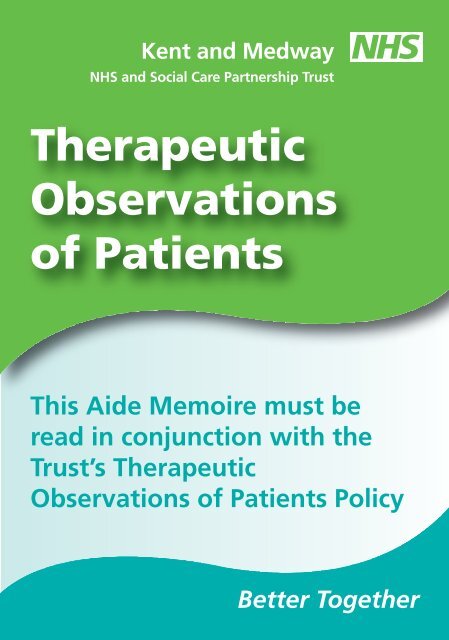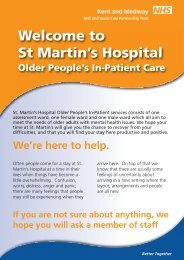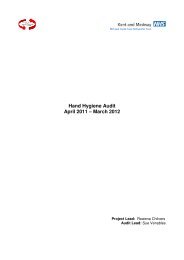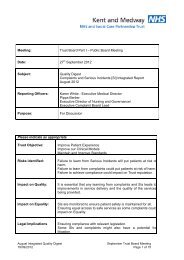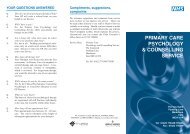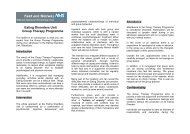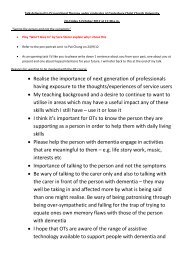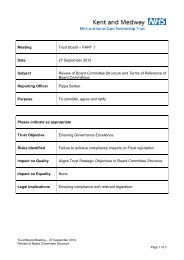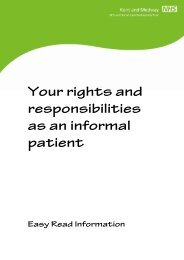Therapeutic Observations of Patients - Kent and Medway NHS and ...
Therapeutic Observations of Patients - Kent and Medway NHS and ...
Therapeutic Observations of Patients - Kent and Medway NHS and ...
You also want an ePaper? Increase the reach of your titles
YUMPU automatically turns print PDFs into web optimized ePapers that Google loves.
<strong>Kent</strong> <strong>and</strong> <strong>Medway</strong><br />
<strong>NHS</strong> <strong>and</strong> Social Care Partnership Trust<br />
<strong>Therapeutic</strong><br />
<strong>Observations</strong><br />
<strong>of</strong> <strong>Patients</strong><br />
This Aide Memoire must be<br />
read in conjunction with the<br />
Trust’s <strong>Therapeutic</strong><br />
<strong>Observations</strong> <strong>of</strong> <strong>Patients</strong> Policy<br />
Better Together
PATIENT OBSERVATIONS<br />
Patient <strong>Observations</strong> are carried out<br />
when there is an immediate or potential<br />
danger <strong>of</strong> a patient harming themselves<br />
or others. This usually includes patients<br />
who have a history <strong>of</strong> self-harm,<br />
violence, vulnerability or being<br />
exploited. The aim is to minimise the<br />
risk <strong>of</strong> harm occurring.
Although the term “Nurse” is used, other<br />
pr<strong>of</strong>essionals may carry out observations.<br />
Observation must not be simply a<br />
custodial activity but should provide the<br />
nurse with an opportunity to interact<br />
with the patient in a therapeutic way on<br />
a one-to-one basis.<br />
Where possible <strong>and</strong> appropriate the nurse<br />
should be the same gender as the patient<br />
in order to protect privacy <strong>and</strong> dignity.
THERE ARE FOUR TYPES OF<br />
OBSERVATION<br />
General<br />
The location <strong>of</strong> all patients should be<br />
known to staff, but not all patients need<br />
to be kept within eyesight.<br />
Intermittent<br />
The patients location is checked every<br />
ten to thirty minutes (exact time to be<br />
specified in the care plan).
Within eyesight<br />
The patient should be within eyesight at<br />
all times.<br />
Within arms length<br />
The patient should be within arms<br />
length at all times.
PROCEDURE<br />
All patients are observed <strong>and</strong> reported on<br />
daily. At all levels <strong>of</strong> observation, the nurse<br />
should be able to report on the patient’s:<br />
• General behaviour<br />
• Movements<br />
• Posture<br />
• Speech<br />
• Expression <strong>of</strong> ideas<br />
• Appearance<br />
• Eating / dietary intake<br />
• Mood, attitude <strong>and</strong> orientation<br />
• Response to medication<br />
• Physical condition
A record must be made in the patients<br />
notes after each period <strong>of</strong> observation<br />
<strong>and</strong> the observation recording form<br />
must be completed for all patients<br />
except those on general observations.
WITHIN ARMS LENGTH<br />
• The observing nurse must maintain<br />
arms length contact at all times,<br />
observing the patients movements,<br />
actions, behaviour, mood etc. This will<br />
enable the nurse to notice any<br />
warning signs, possible suicide<br />
attempts, aggressive outbursts etc.<br />
The patient must be escorted<br />
everywhere, including to the toilet <strong>and</strong><br />
bathroom by the observing nurse.
• The observing nurse should try to<br />
occupy the patient with suitable<br />
activities if appropriate. However, it is<br />
important to bear in mind that the<br />
patient may be too ill to participate or<br />
may wish to remain silent. Upholding<br />
the patients privacy <strong>and</strong> dignity must<br />
be balanced against the safety <strong>of</strong> the<br />
patient, the nurse <strong>and</strong> others.<br />
• The observing nurse must give a verbal<br />
report to the relieving nurse <strong>and</strong> report<br />
any unusual occurrences/observations<br />
to the nurse in charge.
WITHIN EYESIGHT<br />
• The observing nurse must maintain<br />
visual contact at all times, observing the<br />
patients movements, actions, behaviour,<br />
mood etc. This enables the nurse to<br />
notice any warning signs, possible<br />
suicide attempts, aggressive outbursts<br />
etc. The patient can use the toilet,<br />
bathroom etc alone but the observing<br />
nurse must maintain visual contact.
• The observing nurse must try to<br />
occupy the patient with suitable<br />
activities if appropriate but it is<br />
important to bear in mind that the<br />
patient may be too ill to participate or<br />
may wish to remain silent. Upholding<br />
the patients privacy <strong>and</strong> dignity must<br />
be balanced against the safety <strong>of</strong> the<br />
patient, the nurse <strong>and</strong> others.
• The patient must be accompanied to<br />
the therapy programme if attending.<br />
<strong>Patients</strong> should be encouraged to take<br />
part in the therapy programme but<br />
the observing nurse must maintain<br />
visual contact.<br />
• The observing nurse must record <strong>and</strong><br />
give a verbal report to the relieving<br />
staff member <strong>and</strong> report any unusual<br />
occurrences/observations to the nurse<br />
in charge.
INTERMITTENT OBSERVATION<br />
• The observing nurse must observe the<br />
patients whereabouts at agreed intervals<br />
from 10 to 30 minutes as per care plan,<br />
discreetly observing the patients<br />
movements, actions, behaviour, mood<br />
etc. This will enable the nurse to notice<br />
any signs <strong>of</strong> deterioration.<br />
• <strong>Patients</strong> on intermittent observation<br />
must not be granted leave from the<br />
unit without the permission <strong>of</strong> the<br />
MDT. It may be agreed within the MDT<br />
<strong>and</strong> the patients relatives, carers or<br />
friends that they will take responsibility
for the patients safety if all agree that<br />
the patient will benefit from a period<br />
<strong>of</strong> leave away from the unit. This must<br />
be documented in the patients notes.<br />
• <strong>Patients</strong> on intermittent observations<br />
should be encouraged to take part in<br />
the therapy programme. When a<br />
patient engages in therapy the<br />
therapist must be made aware <strong>of</strong> the<br />
patient’s level <strong>of</strong> observations <strong>and</strong> the<br />
reasons they were applied.
GENERAL OBSERVATION<br />
• During a span <strong>of</strong> duty, the nurse<br />
responsible for the patients care must<br />
be able to report at the end <strong>of</strong> the<br />
shift, on the patients movements,<br />
actions, behaviour, mood etc. This will<br />
enable the nurse to have a general<br />
awareness <strong>of</strong> the patient’s<br />
whereabouts, any signs <strong>of</strong><br />
deterioration, unusual occurrences or<br />
incidents in which the patient is<br />
involved <strong>and</strong> what they have done<br />
during the shift.
• The nurse responsible for the patients<br />
care during the shift must make sure<br />
that their colleagues are made aware<br />
<strong>of</strong> any changes immediately.<br />
• An entry must be recorded in patients<br />
notes at the end <strong>of</strong> each shift.<br />
If you require this leaflet in another<br />
format or language please speak to your<br />
manager or call communications on<br />
01732 520441


